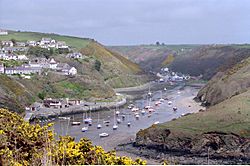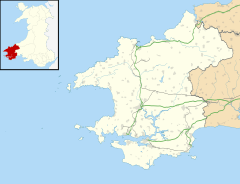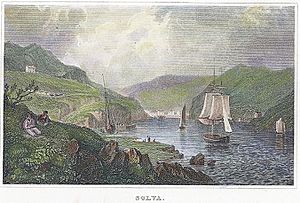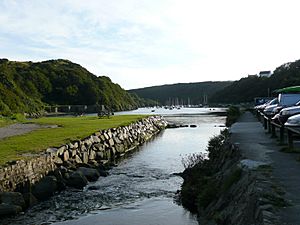Solva facts for kids
Solva (Solfach in Welsh) is a charming village located in Pembrokeshire, Wales. It is also a community and an electoral ward. The village is split into two main parts: Lower Solva, which is by the harbour, and Upper Solva, which sits on the cliff top. The wider community also includes the small areas of Middle Mill and Whitchurch.
Quick facts for kids Solva
|
|
|---|---|
 |
|
| Population | 865 (2011 census) |
| OS grid reference | SM802243 |
| Principal area | |
| Ceremonial county | |
| Country | Wales |
| Sovereign state | United Kingdom |
| Post town | HAVERFORDWEST |
| Postcode district | SA62 |
| Dialling code | 01437 |
| Police | Dyfed-Powys |
| Fire | Mid and West Wales |
| Ambulance | Welsh |
| EU Parliament | Wales |
| UK Parliament |
|
| Welsh Assembly |
|
Contents
Where is Solva?
Solva is found on the north side of St Bride's Bay. This area is part of the beautiful Pembrokeshire Coast National Park. The village also sits right on the Pembrokeshire Coast Path, which is popular for walking.
The village is built in a deep valley, where the River Solva meets the sea. Lower Solva has a long street that leads down to a small, sheltered harbour. Most of the newer buildings are in Upper Solva, which is on the cliffs west of the harbour.
Solva's Past
The rocks at the entrance to Solva Harbour made it a very safe place for ships to anchor. It was one of the best harbours between Fishguard and Milford Haven. In 1578, a map showed it as Dolvath Haven, and by 1748, it was called Solvach.
A Busy Harbour
During the medieval period, Solva became the main trading hub for St Bride's Bay. It was very important for "lime burning." This was a process where limestone was heated to make lime, which was used in farming and building. You can still see a row of old lime kilns preserved by the harbour.
By the late 1700s, Solva was growing. Its harbour could hold ships as large as 500 tons. About 30 ships were registered to the port at this time. Later, in the 1800s, Solva even had an RNLI lifeboat station to help ships in trouble.
From Trade to Tourism
As coastal trade became less common, Solva changed. It became a popular place for tourism. The harbour then became a centre for leisure boats and fun activities on the water.
In 1943, the RAF (Royal Air Force) built an airfield nearby, called RAF St Davids. This airfield is now within the Solva community area. Also, in 1979, Wales's first butterfly farm, Solva Nectarium, opened in the village.
Who Lives in Solva?
In 2011, about 865 people lived in Solva. By 2019, this number had grown slightly to an estimated 869 people.
The 2011 Census also showed that about 30.7% of the people in Solva could speak Welsh. Most of the people living in Solva (96.3%) were born in the United Kingdom. About 54.7% were born in Wales, and 39.2% were born in England.
Solva's Rocks and Landscape
Solva Harbour is a great example of a "ria." A ria is a coastal valley that has been flooded by the sea, creating a long, narrow inlet.
The rocks around Solva contain fossils from the Cambrian period. This was a very early time in Earth's history, over 500 million years ago! The village is so important for geology that a specific group of rocks is named after it: the Solva Group.
Local Events and Fun
Solva hosts several fun events each year:
- Duck Race: Every Easter Monday, Solva holds a charity duck race. Rubber ducks are released into the River Solva near Middle Mill. They float down to Solva harbour, and the first one to pass under the footbridge wins!
- Regatta: Each summer, Solva has a regatta. This is a series of boat races, including rowing competitions for both adults and children.
- The Edge Festival Solva: This festival takes place every year in late July or early August. It raises money for projects that help the local community.
Things to See and Do
The cliffs around Solva are very popular with walkers. The amazing rock formations from the Cambrian period also attract both amateur and professional geologists.
Solva Woollen Mill
Near Solva, in the village of Middle Mill, is the Solva Woollen Mill. It is said to be the oldest woollen mill in Pembrokeshire that has been working continuously. Today, the mill mainly makes carpets and rugs. Visitors can see the looms in action, and there is also a tearoom and a shop.
Famous People from Solva
Solva has been home to, or inspired, several notable people:
- Frances Hodgkins (1869–1947): A painter from New Zealand, she painted in Solva in 1936 and 1938. She wrote about the "nice gentle people" she met there.
- Meic Stevens (born 1942): This famous Welsh singer and songwriter was born in Solva. He spent much of his early life here. In 2002, he released an album called Ysbryd Solfa ("The Spirit of Solfa"), which included songs about his childhood in the village.
- David Gray (born 1968): The musician David Gray moved to Solva when he was 8 years old. His parents ran a craft shop in the village.
- Simon Davies (born 1979): A former professional footballer who played for Fulham and represented Wales many times. He grew up in Solva and started his football career as a teenager at Solva AFC, where he was discovered.
Solva on Screen
In June 2014, Solva was used as a filming location for the movie Under Milk Wood, based on the famous play by Dylan Thomas.
Images for kids
See also
 In Spanish: Solva para niños
In Spanish: Solva para niños









